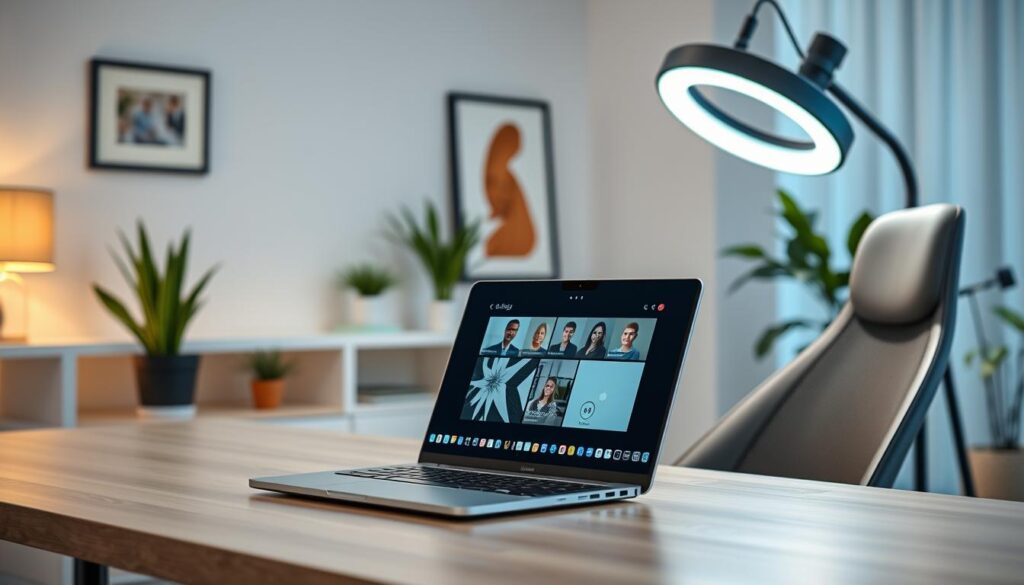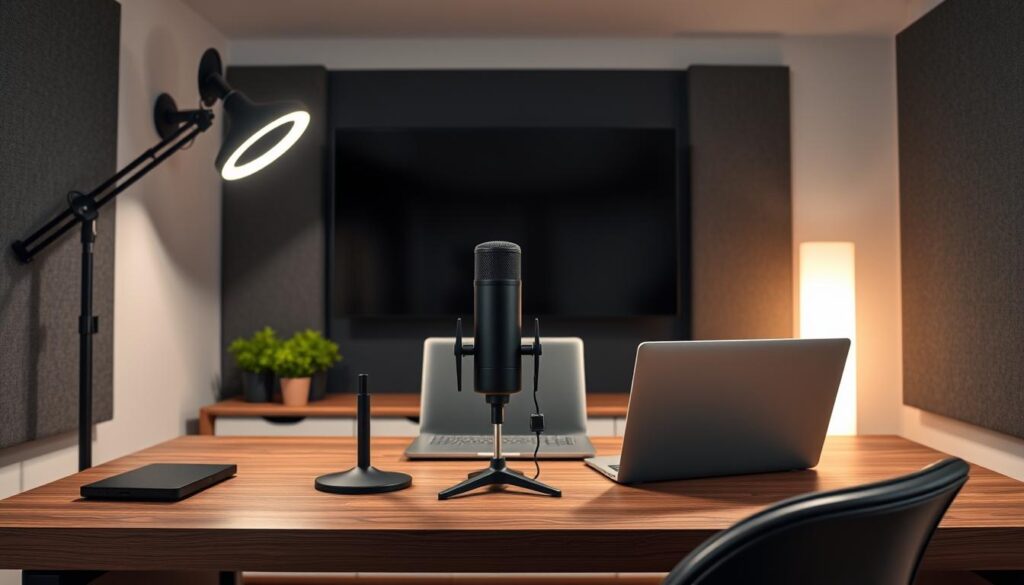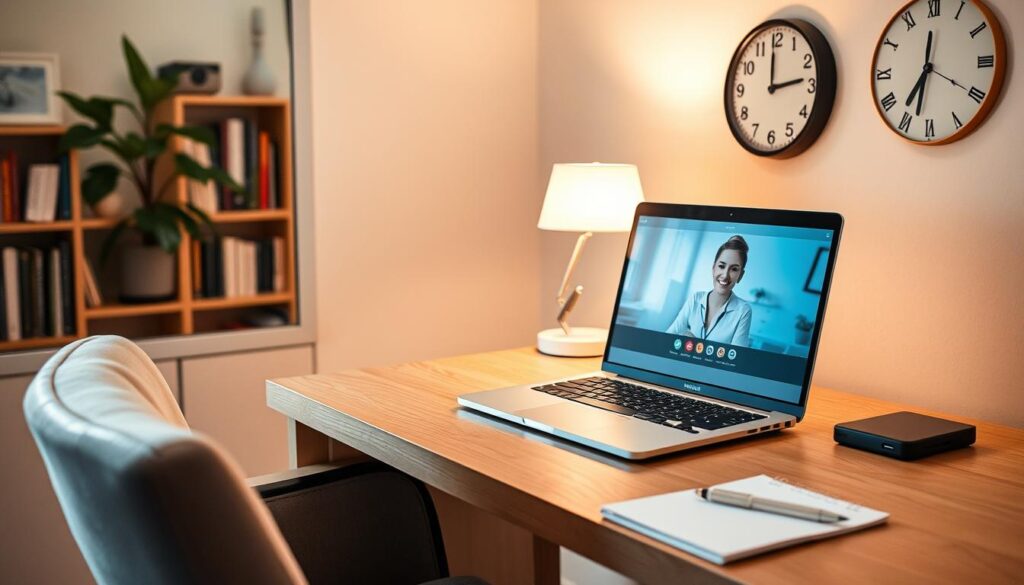Master the Art of Video Conferencing: Tips for Looking and Sounding Professional ?
Master the Art of Video Conferencing: Tips for Looking and Sounding Professional : In today’s world, video conferencing is key for staying in touch, whether it’s for work or personal chats. It’s important to look and sound good on these calls. With the right tips, you can improve how you communicate online and impress others.

By using the best practices for video calls, you can improve your online interactions. This helps you build stronger bonds with your team and clients. Whether you’re in a virtual meeting or presenting to people all over, knowing how to use video conferencing is vital.
Key Takeaways
- Mastering video conferencing skills is key for success in remote work.
- Professional video calls need careful planning and prep.
- Video conferencing tips can boost your online communication skills.
- Looking and sounding professional is key for trust and credibility.
- Learning the best video conferencing practices can really help you in the long run.
- Keeping up with new video conferencing tech and trends is important to stay ahead.
Essential Technical Setup for Professional Video Calls
To make professional video calls clear and confident, you need the right setup. This means a stable internet, a top-notch camera, and a quality microphone. By following the best practices for remote meetings, you can have a smooth video call experience. The right equipment is key for online presentation skills.
Some important things to think about for your setup include:
- Choosing a reliable video conferencing platform that meets your needs
- Investing in a good camera and microphone to ensure high-quality video and audio
- Optimizing your internet connection to prevent lag or dropped calls
Setting up your technical equipment right lets you focus on improving your online presentation skills. A stable internet is key for a smooth video call. With the right setup and practice, you can get better at video conferencing.
By following these tips, your video calls will be professional, effective, and engaging. Whether for business or personal use, the right technical setup is vital. So, start improving your online presentation skills today.
| Technical Requirement | Importance |
|---|---|
| Stable Internet Connection | High |
| High-Quality Camera | Medium |
| Good Microphone | High |
Creating the Perfect Lighting Setup
Proper lighting is key for a good impression in virtual communication. In video conferencing, your face needs to be well-lit. Natural light is the best, so sit near a window or in a bright room.
Stay away from harsh overhead lights. They can make unflattering shadows on your face. A good lighting setup helps you look your best. Here are some tips for the perfect lighting:
- Use softbox lights or ring lights to reduce harsh shadows
- Position your light source at a 45-degree angle to your face
- Avoid mixing different light sources, such as natural and artificial light
Follow these tips for a professional look in video calls. Proper lighting is vital for a positive image in virtual communication.
With the right lighting, you can focus on the conversation. This helps build strong relationships with colleagues and clients. It’s a key part of video conferencing etiquette.
Mastering Your Camera Presence and Angles
To make video calls engaging, you need to get good at camera presence and angles. This means keeping eye contact, using positive body language, and setting up your camera right. These tips help you connect with your audience, even when you’re not in the same room.
Camera positioning is very important. You should set your camera at a distance that lets you move easily. This makes you feel more at ease and natural, which is key for connecting with your audience.
Ideal Camera Positioning
Here are some tips for the best camera position:
- Put your camera at eye level to feel connected with your audience.
- Set your camera at a slight angle to add depth and interest.
- Try different camera heights to find what works best for you and your audience.
Body language is also key in mastering your camera presence. Keep your body open and positive, like uncrossing your arms and standing up straight. This shows confidence and excitement.
By improving your camera presence and angles, you’ll make your video calls more engaging. Practice often and try different things to see what works best for you and your audience.
Professional Audio Practices for Clear Communication
Good audio is key for video calls, just like a strong internet connection. A top-notch microphone is a smart buy. It boosts your audio quality, making your message clear and strong.
Wear headphones to cut down echo and outside noise. This keeps you focused and ensures your words are heard well. Speaking clearly and with confidence also matters a lot. These steps help you communicate well, even when you’re not in the same room.

- Investing in a high-quality microphone
- Using headphones to eliminate echo and background noise
- Speaking clearly and confidently
By using theseprofessional audio practicesin your video calls, you’ll talk better and impress more people.
Designing Your Background for Maximum Impact
Your background in video conferencing matters a lot. A messy background can be off-putting. But a clean, organized space makes you look more professional. This is why background design is so important.
You have two main choices: virtual and physical backgrounds. Virtual backgrounds are easy to change but might not look real. Physical backgrounds look authentic but are harder to set up and keep up.
Virtual vs. Physical Backgrounds
Think about your video call’s purpose and the image you want to show. For a formal look, go with a physical background. But for a personal touch, virtual backgrounds are better.
Organizing Your Visible Space
To look professional, keep your space tidy. Remove clutter, clean your desk, and position your camera right. This creates a clean background that helps you stay focused and professional.
Here are some tips for a tidy space:
- Remove anything you don’t need from your desk or background.
- Use a plain colored wall or backdrop to reduce distractions.
- Position your camera to capture a clean, minimalistic background.
Managing Background Distractions
It’s key to manage distractions during your calls. Turn off notifications, close tabs you don’t need, and ask others to be quiet. By doing this, you stay focused and professional. A well-designed background and a distraction-free space help you make a great impression and reach your goals.
| Background Type | Advantages | Disadvantages |
|---|---|---|
| Virtual Backgrounds | Easily customizable, flexible | May not look realistic |
| Physical Backgrounds | Look authentic, professional | Require more effort to set up and maintain |
Master the Art of Video Conferencing Through Practice
To become a pro at video conferencing, you need to practice and self-review your skills. This means recording techniques to review your calls and find areas to get better. By doing this, you can improve over time and make professional video calls with confidence.
Recording and Self-Review Techniques
Recording your video calls lets you see how you did, find mistakes, and get better. You can use software to review your calls and note what you did right and what you can do better. This way, you can practice and self-review your skills, making your video calls better.
Common Mistakes to Avoid
Some common mistakes to avoid include bad lighting, poor audio, and distractions. Knowing these mistakes helps you avoid them and improve your video calls. Here are some tips to help you avoid these mistakes:
- Use good lighting to ensure you are well-lit and visible on camera.
- Invest in a good quality microphone to ensure your audio is clear and crisp.
- Choose a quiet and private space for your video calls to minimize distractions.

By following these tips and practicing and self-reviewing your video conferencing skills, you can become a pro. Use recording techniques to review your calls and find areas to improve. Don’t be afraid to try new things and experiment with different approaches.
| Tips for Improving Video Conferencing Skills | Description |
|---|---|
| Practice and self-review | Record your video calls and review them to identify areas for improvement. |
| Use good lighting | Ensure you are well-lit and visible on camera. |
| Invest in a good quality microphone | Ensure your audio is clear and crisp. |
Professional Attire and Appearance Tips
Your professional attire matters a lot in virtual meetings. Wearing business clothes, even at home, shows confidence and authority. This helps build trust and credibility with your audience, even online.
To look professional on video calls, follow these tips:
- Wear clothes that are clean and ironed
- Choose colors that complement your skin tone and the background
- Pay attention to your grooming and personal style
- Keep jewelry and accessories to a minimum
A good virtual meeting appearance also boosts your focus. Dressing professionally and taking care of your look shows a positive and professional image, even online.
Your clothes and how you look greatly affect how others see you. Dressing well and taking care of your grooming shows you’re trustworthy and professional. This helps you project a positive and professional image.
| Tips for Professional Attire | Benefits |
|---|---|
| Dress in business attire | Appear more confident and authoritative |
| Pay attention to grooming and personal style | Project a positive and professional image |
| Keep jewelry and accessories to a minimum | Avoid distractions and maintain a professional focus |
Managing Technical Difficulties Like a Pro
Video conferencing can face technical difficulties. But, with the right mindset and prep, you can handle them well. It’s key to have a backup plan, like a solid internet connection and knowing your video conferencing software.
This helps you quickly fix issues like bad audio or video. You can then get back to your meeting fast. Here are some tips for dealing with tech problems:
- Have a backup internet, like a mobile hotspot
- Know your video conferencing software well
- Learn to fix common problems, like bad audio or video
Being ready and having a plan helps you stay professional, even with technical difficulties. Remember, fixing problems is about being proactive and having the right tools.
With these tips and some practice, you’ll manage tech issues like a pro. Your video conferences will run smoothly and efficiently.
| Technical Difficulty | Troubleshooting Tip |
|---|---|
| Poor audio quality | Check your microphone settings and ensure that your audio is not muted |
| Poor video quality | Check your camera settings and ensure that your video is not blocked by another application |
| Internet connection issues | Check your internet connection and consider using a backup connection, such as a mobile hotspot |
Virtual Meeting Etiquette and Best Practices
When you’re in a virtual meeting, virtual meeting etiquette is key. It helps build trust and credibility with your audience. By using best practices for online meetings, your virtual meetings will be engaging, productive, and respectful.
To have a successful virtual meeting, keep these tips in mind:
- Be on time and start the meeting promptly
- Speak professionally and use the right tone
- Keep distractions and background noise to a minimum
- Send a follow-up to attendees after the meeting
By following these tips, you can create a positive and professional atmosphere online. Remember, virtual meeting etiquette is vital for making a good impression and reaching your meeting goals.
Mastering best practices for online meetings can elevate your virtual meetings. It can lead to greater success in your personal and professional life.
Building trust and credibility with your audience is key to a successful virtual meeting. By following virtual meeting etiquette and best practices, you can establish a strong foundation for effective communication and collaboration.
Conclusion: Elevating Your Virtual Presence
Mastering video conferencing is key in today’s digital world. By following the tips in this guide, you can improve your virtual presence. Focus on your technical setup, camera presence, audio quality, and background design.
With practice, you’ll get better at video conferencing. Use this skill to connect with others, even when you’re far apart. A strong virtual presence helps you share your message and personality effectively.
Now, it’s time to apply what you’ve learned. Keep practicing and improving your video conferencing skills. By doing so, you’ll enhance your virtual presence and make the most of this powerful tool.
FAQ
What are the essential technical requirements for professional video calls?
For smooth video calls, you need a stable internet, a top-notch camera, and a good mic. Pick the right platform, optimize your internet, and get the right gear. These steps are key for professional calls.
How can I create the perfect lighting setup for video calls?
Good lighting makes you look great on camera. Natural light is best, so sit near a window. Avoid harsh lights that create shadows.
Invest in a good lighting setup to look your best.
What are the tips for mastering your camera presence and angles?
Eye contact, positive body language, and the right camera angle are important. Look straight at the camera and use open body language. Place your camera at eye level for a natural look.
How can I ensure professional audio quality during video calls?
Clear audio is key for good communication. Invest in a quality mic. Use headphones to avoid echo and speak clearly. Follow audio best practices for clear messages.
How can I design a professional background for my video calls?
Your background matters a lot. Choose a clean, distraction-free background. Organize your space and manage distractions. A professional background helps you look good.
How can I practice and improve my video conferencing skills?
Practice makes perfect. Record and review your calls to spot areas for improvement. Use software to review and practice. Avoid common mistakes like bad lighting or audio. With practice, you’ll get better at video calls.
What are the professional attire and appearance tips for video calls?
Dress professionally, even from home. Pay attention to grooming and style. Looking professional builds trust and credibility, even online.
How can I manage technical difficulties during video calls?
Technical issues can be a hassle. Have a backup plan and know how to fix common problems. Keep a spare internet connection and know your software. Being prepared helps you stay professional, even with tech issues.
What are the best practices for conducting virtual meetings?
Follow virtual meeting etiquette to build trust and credibility. Be on time, use professional language, and follow up. These practices make your virtual meetings engaging and productive.
